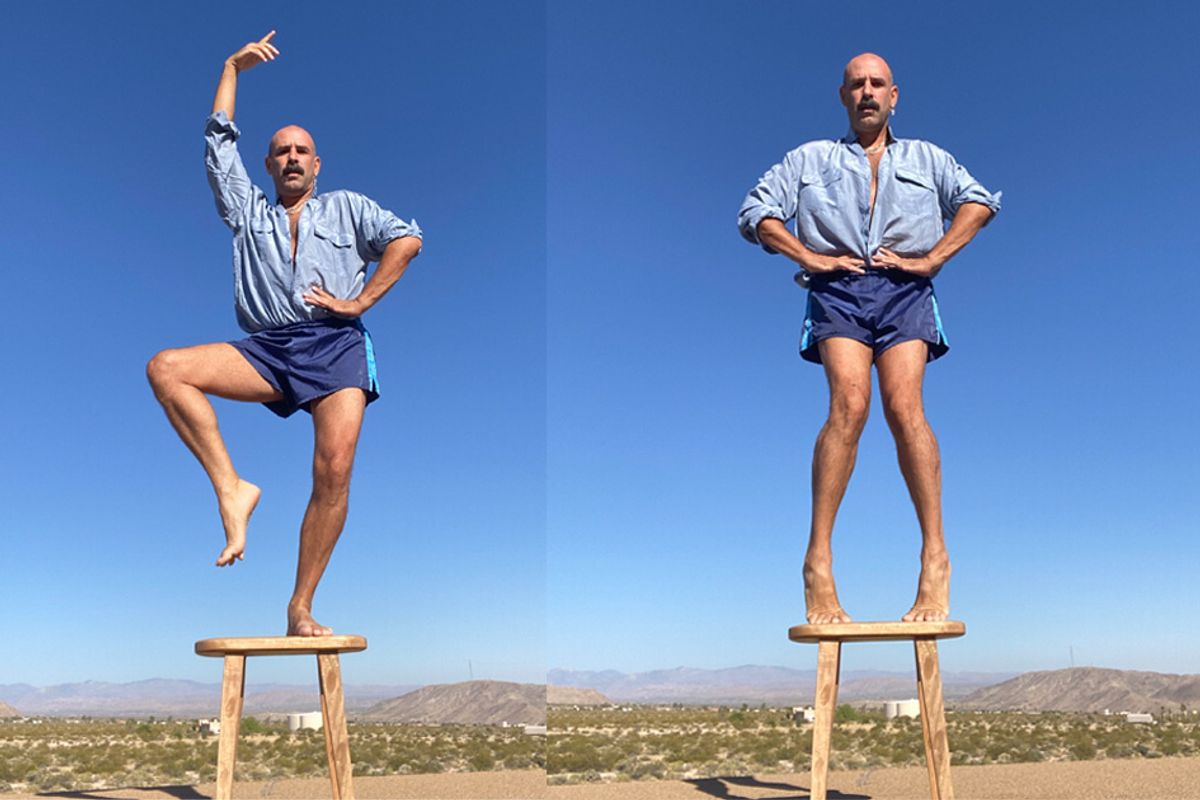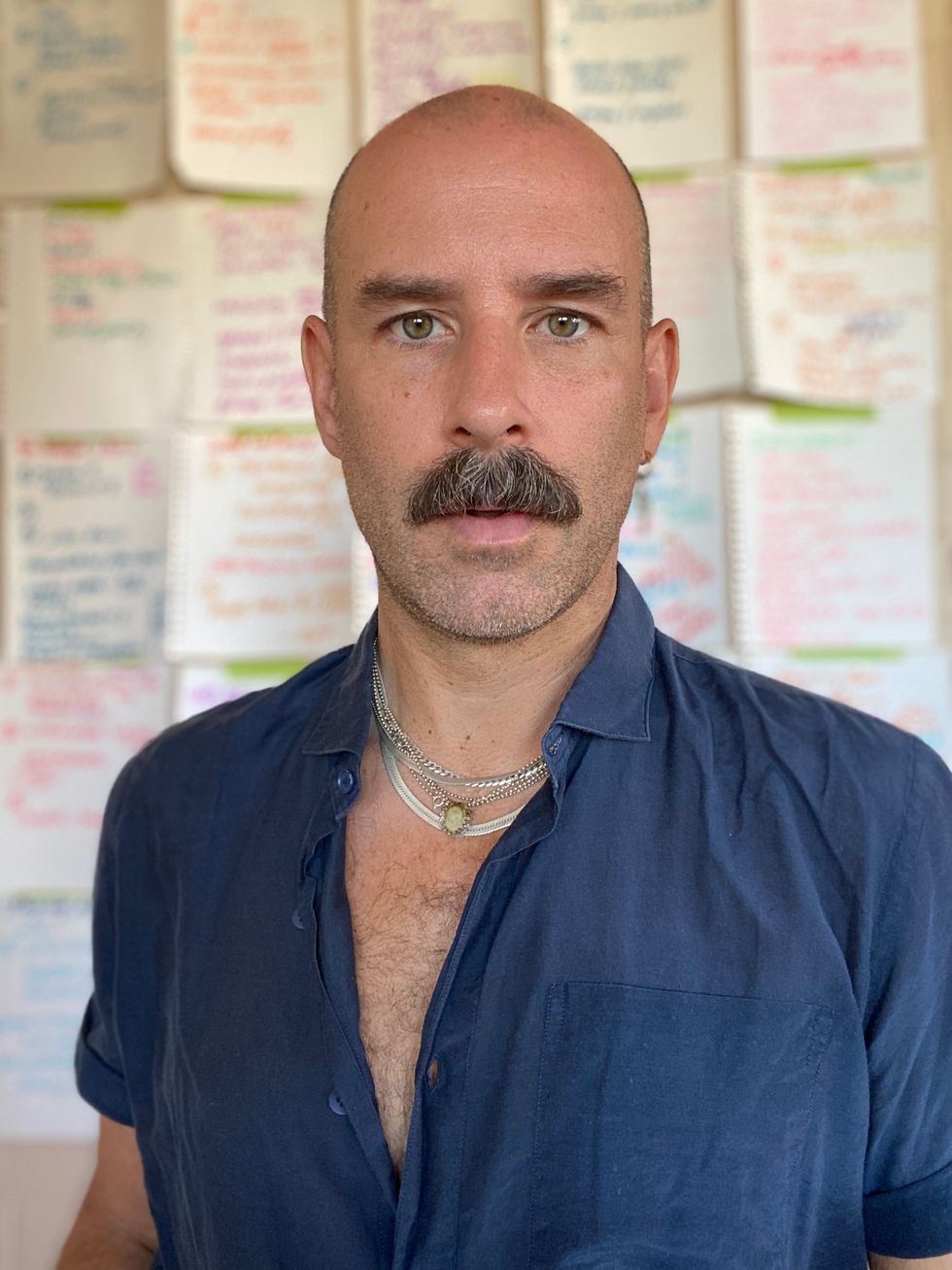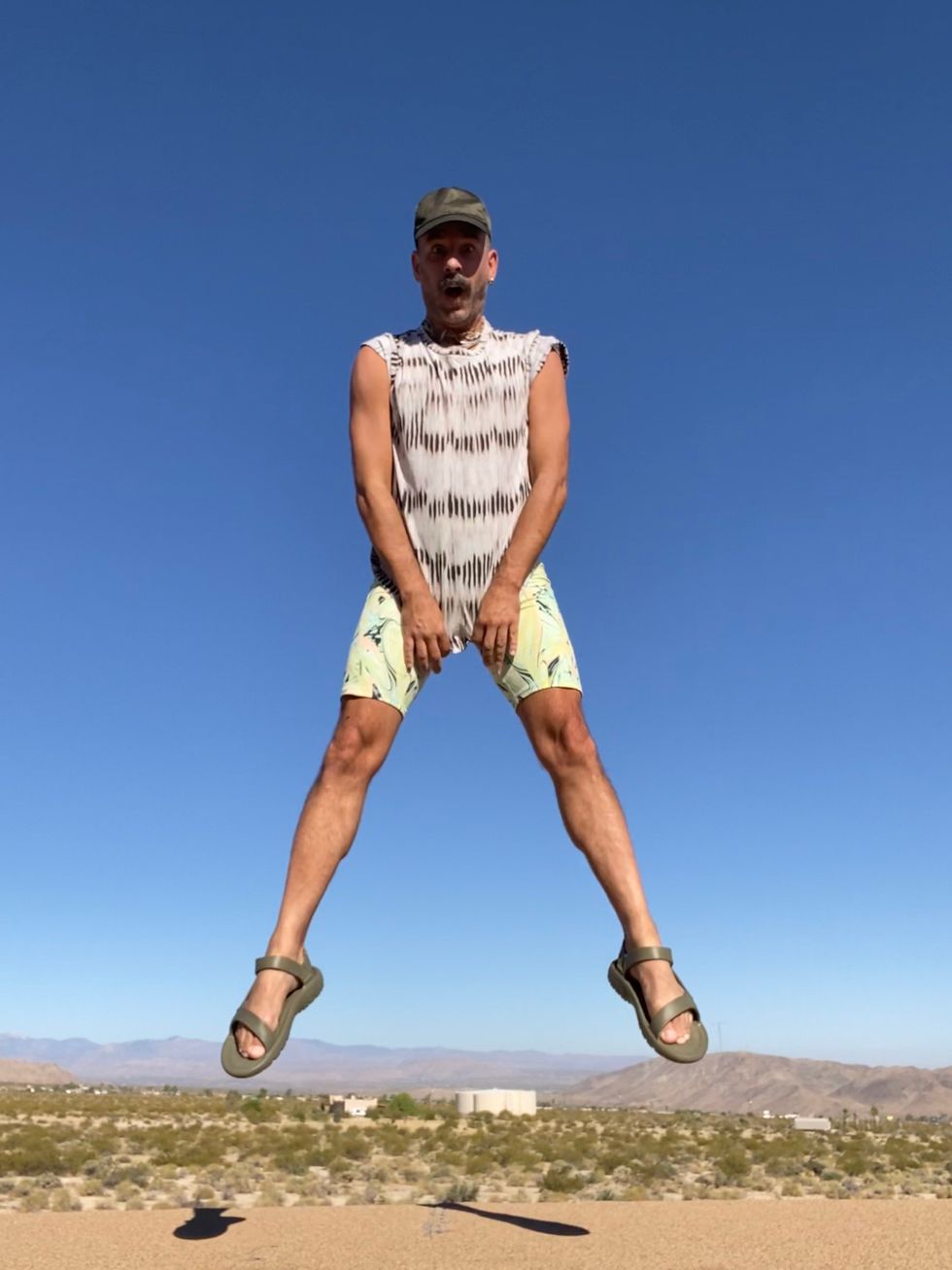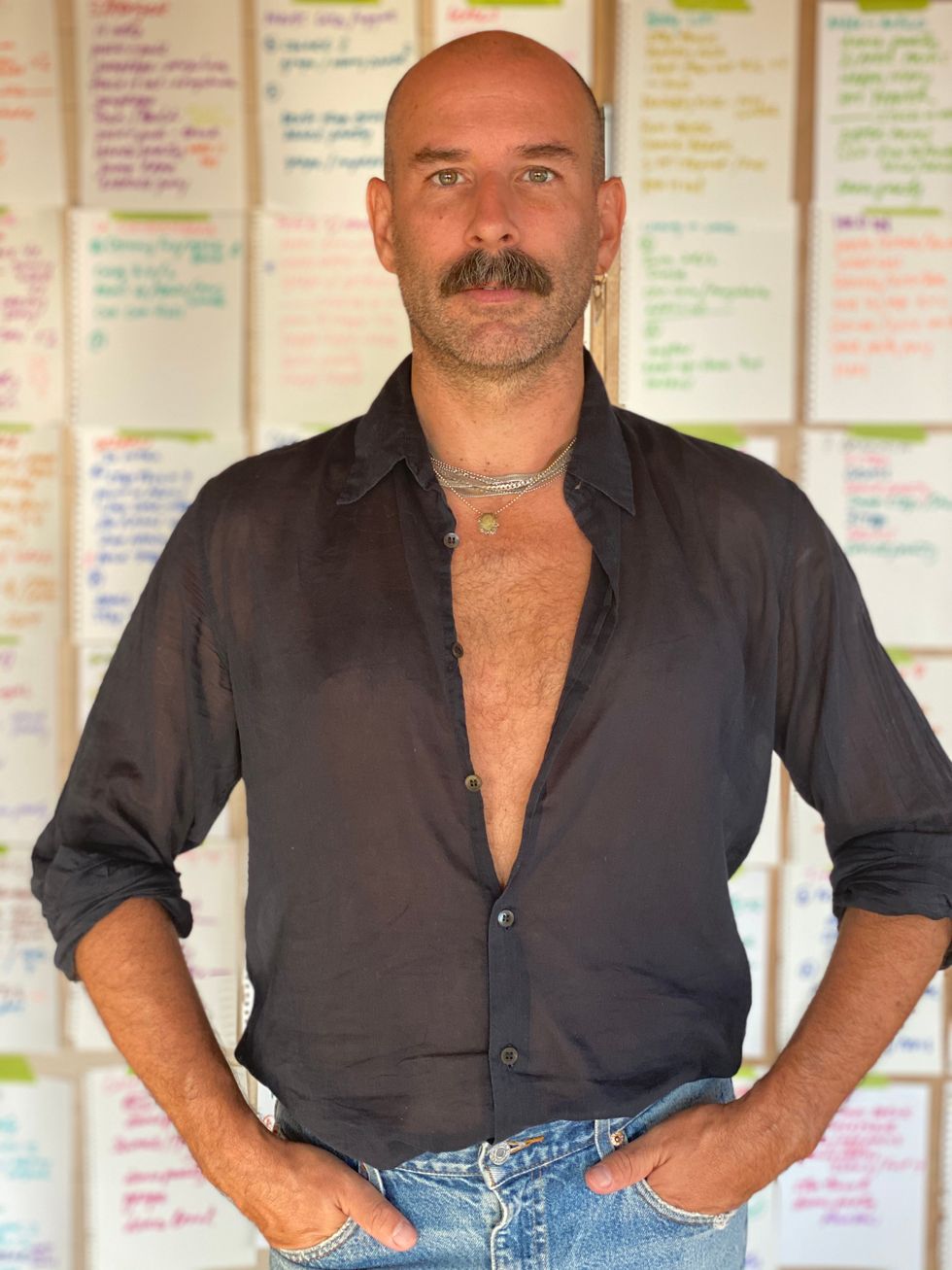
“Annnnnnnd—we’re back!”
Ryan Heffington is kneeling in front of his iPhone, looking directly into the camera, smiling behind his bushy mustache. He’s in his house in the desert near Joshua Tree, California, phone propped on the floor so it stays steady, his bright shorty shorts, tank top and multiple necklaces in full view. Music is already playing—imagine you’re at a club—and soon he’s swaying and bouncing from side to side, the beat infusing his bones.
“Hey, London! Sweden in the house!” As people join the Instagram feed, he greets dancers from all over the globe as though they were walking into the studio. “Hi, India! Oh, there’s Ashley!” This is how, for the last seven months, Heffington has started his über-popular once-daily, now-weekly dance-class-turned-spiritual-experience, SWEATFEST.
If you’ve searched “quarantine dance class,” chances are you’ve stumbled upon Heffington’s—a high-energy, easy-to-follow class that melds yoga, meditation, contemporary dance, aerobics and club dancing (with costumes and celebrity guests, to boot) into an hour-long sweaty pocket of joy. Back in March, he had around 500 viewers (“I thought my students in L.A. would take class, at least,” he says). Today, his classes have reached up to an astonishing 100,000 students, and have garnered praise from everyone, including Reese Witherspoon and J.Lo. His Instagram feed is full of comments like “Biggest smile of my day” and “This is everything” and “You are just pure spirit when you dance.”

Before quarantine, Heffington was best known for being Hollywood’s go-to guy for quirky choreography, with credits on music videos like Sia’s “Chandelier” and Arcade Fire’s “We Exist,” television shows from “Transparent” to “Pose” to “The OA,” and movies like Baby Driver. But long before he was a household name amongst commercial-dance aficionados, he was a teacher.
“Teaching has always been an outlet for creativity,” Heffington says. “As a choreographer, I had a space to go every week to instruct and communicate a new language to my students. That is what helped shape my movement vocabulary and created community.”
Before opening his own studio, Heffington taught for 15 years all over Los Angeles. His classes were a hybrid of his own making—a meld of contemporary, club dancing, modern, disco, and punk rock. They were not an instant success, however, with sometimes as few as three students in attendance. “I would show up no matter what,” he says. “That’s been instilled in my work ethic.”
But Heffington’s popularity shifted when he started offering his classes to “the masses,” as he puts it. He became notorious for organizing wild underground dance performance/parties in clubs all over Los Angeles. Club-goers swarmed him, wanting to know how to dance like him. So he started Sweaty Sundays and Wet Wednesdays—at 10 pm, in the clubs. “Seventy people would show up, grab a drink and get on the dance floor.” The moves themselves weren’t all that different from his typical classes, but instead of using dance terms, he’d play around: “tour jeté” would become “speed skater.” You don’t need to know the lingo to dance, seemed to be his message.

With a solid following from the clubs, in 2010 he opened The Sweat Spot, a relatively large, grungy space off a parking lot in Silver Lake. “I knew nothing about business,” he says. “The learning curve was so steep, but I just had to do it. I never envisioned this alternative choreographer/punk-rock teacher as a business owner!”
“Dance class for everyone”: This was The Sweat Spot’s tagline. The mission was different from those of other studios in L.A., which were competitive and focused mostly on commercial dance. “I wanted to create a space that was accessible, inviting and safe,” Heffington says. “Anyone starting to dance past their 20s doesn’t want to be a professional dancer! They just want to feel good and empowered! Sweat Spot teachers needed to be cautious of those fragile beings.”
Over the next 10 years, thousands of people walked through the doors of the studio. The person next to you was as likely to be your dentist or Madonna’s backup dancer or a queer boy who’d just arrived from Arkansas—that’s how eclectic and open the community was. Heffington’s classes alone would sell out at 75 people because he couldn’t bear turning people away. (I have danced in the space; 75 is extremely crowded.) But the studio offered a little of everything—beginning, intermediate and advanced contemporary, ballet, hip hop, as well as Pilates and Dance Church classes.

“What came out of Sweat Spot was that people who never had a love for dance found it,” says Melissa Schade, who taught at the studio. And thanks to Heffington, The Sweat Spot also became a place where Los Angeles’ budding teachers and choreographers could experiment and play before venturing into more cutthroat settings. “We were taught to be more patient, to create an inclusive environment, and to make it fun for everyone,” she says.
Heffington’s teaching philosophy has always been one of self-empowerment. “I like to say ‘Do you,'” he explains. “I hardly ever give corrections. Unless someone is being unsafe or going the wrong way, it’s about them. I dance the way I dance, and you dance the way you dance. Both are beautiful.”
This philosophy extends well beyond the dance floor, which is perhaps one of the reasons his teaching has now, in a moment of such uncertainty and fear, touched tens of thousands of people, even through the tiny frames of our phones. “He always said, ‘When you fall or make a mistake, go into it further,'” says dancer and teacher Jasmine Albuquerque, who has known Heffington for over 15 years. “I now teach that to my students. When they mess up, it looks better. It’s different to become a human again when you’ve been a trained dancer. Ryan keeps that humanness and dancer-ness in such a nice balance. His classes are magic. They’re therapy.”

When the coronavirus hit, Heffington fled Los Angeles and moved to the desert. He started SWEATFEST on a whim, as a one-off on Instagram, but soon he was teaching it five days a week, spending three hours a night picking songs and figuring out combinations, taping the routines up on his walls as cheat sheets. “I was experiencing isolation, and dance is therapeutic,” he says. “I knew it would be for other people, so I said, ‘I’m going to pied-piper it.'” The success was wonderful but overwhelming. (Eventually, he switched from daily classes to weekly ones because he could feel that he was close to burning out.)
Students dancing in their own living rooms responded to both the upbeat joy of it and the quiet, often emotional, meditation at the end, in which Heffington asks students to close their eyes, feel the lightness and love in their bodies, and then give that energy to the people who need it the most. “Reverence is for people to be accountable for what they just created,” he says. “This is why people get so emotional. They’re not used to taking responsibility for a great time. They say, ‘It’s because of you!’ No! We’re making the magic together! A lot of emotions come up. It’s beautiful.”
Soon, SWEATFEST turned into much more than a dance class or even a venue for personal freedom. It became a forum for talking about the country’s current political upheaval, and a way to raise money for organizations like Black Lives Matter, Black Trans Advocacy Coalition, the ACLU, the NAACP and a dancers’ relief fund. (He raised over $100,000 for BLM and ACLU alone in a matter of weeks.) At the end of each class he’d say, “We are in this revolution. Let’s keep the fight because we can only get through this if we get through it together.”

With The Sweat Spot’s lease coming to an end in January, Heffington realized that keeping the space afloat just wasn’t financially sustainable without in-person classes. So his teaching, for the foreseeable future, will all be online. This was, of course, not what he’d envisioned just a few months ago, when he was close to buying a building in Los Angeles. “It feels like an end of an era,” Heffington says. “There were a lot of tears on the Zoom call with the other teachers.”
“It was the birthplace of all of our careers,” says Albuquerque. “It has so many footsteps. Ryan takes dust and turns it into glitter. He has no fear.” Heffington’s fearlessness seems oddly suited to this tumultuous moment: “We were once in his class and there was an earthquake,” Albuquerque says. “And he said, ‘Just keep stretching, girl.'”
Heffington recently returned to New York City to choreograph Tick Tick…Boom!, a film directed by Lin-Manuel Miranda, based on the play by Jonathan Larson. Though he has no plans to reopen The Sweat Spot, he’ll keep teaching on Instagram, and using it as a platform to help people through these tough times.
“Once you cultivate self-esteem in class, it’s not only about you in the dance space, it becomes a part of you in your everyday life,” he says. “You can share that ‘you’ with other people. Whether or not you learn the steps, it’s about feeling good.”




